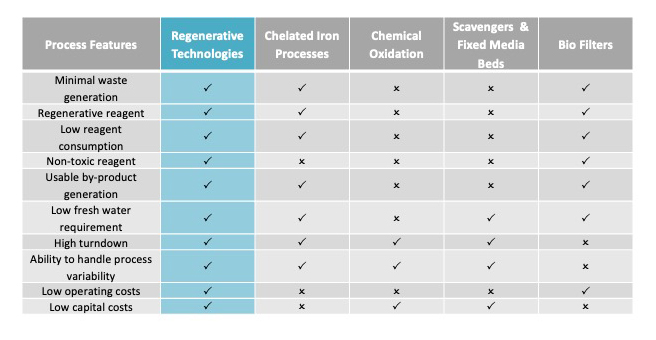Regenerative Hydrogen Sulfide Removal in the Biogas Industry: Innovative Solutions for Sustainable Gas Purification
June 10, 2024
Author: Chris Ristevski, Macrotek Inc.
Hydrogen sulfide (H₂S), a colorless gas known for its characteristic "rotten egg" odor, is a common impurity in biogas. Its presence in high concentrations poses significant health hazards, causes corrosion in equipment, and reduces the commercial value of biogas. As global interest in renewable energy rises and environmental regulations tighten, efficient and sustainable methods for H₂S removal have become crucial in the biogas industry.
The Challenge: Hydrogen Sulfide in Biogas Production
Biogas, produced from the anaerobic digestion of organic materials like agricultural waste, manure, and sewage sludge, is a renewable energy source gaining prominence worldwide. However, biogas typically contains 0.1% to 1% H₂S, varying based on the feedstock composition and digestion process. Elevated levels of H₂S can lead to:
- Health Risks: H₂S is toxic and can pose severe health hazards to workers in high concentrations.
- Corrosion: H₂S combines with water to form sulfuric acid, which corrodes biogas plant equipment, reducing its lifespan.
- Environmental Impact: Untreated H₂S emissions can harm the environment and violate regulatory standards.
- Reduced Energy Value: H₂S reduces the heating value of biogas and causes sulfur dioxide emissions upon combustion.
Traditional H₂S Removal Technologies in Biogas Applications
Several conventional methods have been used for H₂S removal in biogas plants, each with unique strengths and limitations:
- Iron Sponge Process: Involves iron oxide-coated wood chips that react with H₂S to form iron sulfide. However, the material requires frequent replacement due to saturation.
- Activated Carbon Adsorption: Adsorbs H₂S onto activated carbon surfaces. Despite its simplicity, the carbon requires frequent replacement or regeneration.
- Biological Filters (Biofilters): Use sulfur-oxidizing bacteria to convert H₂S into elemental sulfur. While eco-friendly, biofilters require careful moisture and temperature control.
Regenerative H₂S Removal Solutions in the Biogas Industry
In the biogas sector, regenerative H₂S removal technologies offer sustainable alternatives to traditional methods. They focus on removing H₂S efficiently while allowing the sorbent material to be regenerated and reused multiple times. Key advantages include reduced operational costs, minimized waste, and consistent performance over prolonged periods.
- Chemical Absorption with Regenerative Amines: Amine-based solvents, such as methyl diethanolamine (MDEA), are used in regenerative H₂S removal systems. In this process, biogas containing H₂S is contacted with an amine solution, forming hydrogen sulfide complexes. These complexes are then heated in a stripper column to release H₂S gas, regenerating the amine solution for reuse. Key benefits for the biogas industry include:
- High selectivity and absorption capacity for H₂S.
- Compatibility with CO₂ removal, providing a comprehensive purification solution.
- Oxidative Absorption Using Liquid Redox Systems: Liquid redox systems employ aqueous solutions of chelated iron or other metal catalysts to oxidize H₂S into elemental sulfur. The sulfur can be easily separated, and the catalyst solution
is regenerated by oxidizing the metal ions back to their original state. Advantages for biogas plants:
- High efficiency even at low H₂S concentrations.
- Production of elemental sulfur, which has commercial value.
- Minimal chemical consumption due to regeneration.
- Solid Sorbents for Regenerative Desulfurization: Solid sorbents, such as metal oxides (e.g., zinc oxide, iron oxide) and activated carbons, can selectively adsorb H₂S. These sorbents are regenerated by heating or treating them
with a reducing gas. Features and benefits for biogas purification:
- High sulfur loading capacities.
- Regeneration through temperature or gas-based treatments.
- Tailored selectivity for biogas compositions.
- Biological Regenerative Desulfurization: Biological processes use sulfur-oxidizing bacteria to convert H₂S into elemental sulfur. The gas stream is passed through a bioreactor containing a biofilm of these bacteria, which oxidizes the H₂S. The sulfur is then separated, and the bioreactor regenerated for continuous operation. An advantage for the biogas industry:
- Suitable for treating varying concentrations of H₂S in biogas streams.

Conclusion: Advancing Sustainability in Biogas Purification
Regenerative H₂S removal technologies represent a significant leap forward in biogas purification. By minimizing waste, reducing operational costs, and recovering valuable byproducts like sulfur, these systems offer an eco-friendly and economically viable solution to the challenges posed by H₂S.
While each technology has its specific advantages and ideal applications, the future of H₂S removal in the biogas industry will likely involve regenerative H₂S removal systems.
Ultimately, regenerative H₂S removal aligns perfectly with the broader push toward sustainable industrial practices, benefiting not just individual companies but also the environment at large.







Leave a comment